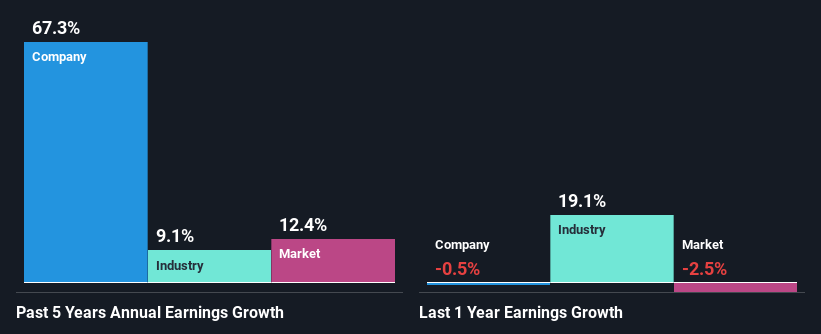IDOX plc's (LON:IDOX) Has Had A Decent Run On The Stock market: Are Fundamentals In The Driver's Seat?
IDOX's (LON:IDOX) stock up by 1.5% over the past three months. We wonder if and what role the company's financials play in that price change as a company's long-term fundamentals usually dictate market outcomes. Particularly, we will be paying attention to IDOX's ROE today.
Return on equity or ROE is a key measure used to assess how efficiently a company's management is utilizing the company's capital. Simply put, it is used to assess the profitability of a company in relation to its equity capital.
Check out our latest analysis for IDOX
How Do You Calculate Return On Equity?
Return on equity can be calculated by using the formula:
Return on Equity = Net Profit (from continuing operations) ÷ Shareholders' Equity
So, based on the above formula, the ROE for IDOX is:
7.6% = UK£5.6m ÷ UK£73m (Based on the trailing twelve months to October 2023).
The 'return' refers to a company's earnings over the last year. So, this means that for every £1 of its shareholder's investments, the company generates a profit of £0.08.
What Is The Relationship Between ROE And Earnings Growth?
So far, we've learned that ROE is a measure of a company's profitability. Depending on how much of these profits the company reinvests or "retains", and how effectively it does so, we are then able to assess a company’s earnings growth potential. Generally speaking, other things being equal, firms with a high return on equity and profit retention, have a higher growth rate than firms that don’t share these attributes.
IDOX's Earnings Growth And 7.6% ROE
When you first look at it, IDOX's ROE doesn't look that attractive. A quick further study shows that the company's ROE doesn't compare favorably to the industry average of 10% either. However, we we're pleasantly surprised to see that IDOX grew its net income at a significant rate of 67% in the last five years. Therefore, there could be other reasons behind this growth. For example, it is possible that the company's management has made some good strategic decisions, or that the company has a low payout ratio.
As a next step, we compared IDOX's net income growth with the industry, and pleasingly, we found that the growth seen by the company is higher than the average industry growth of 9.1%.
Earnings growth is an important metric to consider when valuing a stock. What investors need to determine next is if the expected earnings growth, or the lack of it, is already built into the share price. By doing so, they will have an idea if the stock is headed into clear blue waters or if swampy waters await. Is IDOX fairly valued compared to other companies? These 3 valuation measures might help you decide.
Is IDOX Making Efficient Use Of Its Profits?
IDOX's three-year median payout ratio is a pretty moderate 38%, meaning the company retains 62% of its income. By the looks of it, the dividend is well covered and IDOX is reinvesting its profits efficiently as evidenced by its exceptional growth which we discussed above.
Moreover, IDOX is determined to keep sharing its profits with shareholders which we infer from its long history of paying a dividend for at least ten years. Our latest analyst data shows that the future payout ratio of the company is expected to drop to 29% over the next three years. As a result, the expected drop in IDOX's payout ratio explains the anticipated rise in the company's future ROE to 14%, over the same period.
Conclusion
In total, it does look like IDOX has some positive aspects to its business. Even in spite of the low rate of return, the company has posted impressive earnings growth as a result of reinvesting heavily into its business. That being so, a study of the latest analyst forecasts show that the company is expected to see a slowdown in its future earnings growth. To know more about the company's future earnings growth forecasts take a look at this free report on analyst forecasts for the company to find out more.
Have feedback on this article? Concerned about the content? Get in touch with us directly. Alternatively, email editorial-team (at) simplywallst.com.
This article by Simply Wall St is general in nature. We provide commentary based on historical data and analyst forecasts only using an unbiased methodology and our articles are not intended to be financial advice. It does not constitute a recommendation to buy or sell any stock, and does not take account of your objectives, or your financial situation. We aim to bring you long-term focused analysis driven by fundamental data. Note that our analysis may not factor in the latest price-sensitive company announcements or qualitative material. Simply Wall St has no position in any stocks mentioned.

 Yahoo Finance
Yahoo Finance 
